Mohammed Shami, Shikhar Dhawan, Kuldeep Yadav and the Chennai Super Kings batters are in the spotlight this week in our IPL analysis. Read on for our insights as we break down interesting numbers from the world’s biggest T20 competition.
Shami’s role for Gujarat has changed substantially from last season.
Mohammed Shami is bowling with more control in the death overs
Since his switch to the Gujarat Titans, Mohammed Shami has thrived in the IPL.
Sixth in the Purple Cap standings for most wickets in 2022 with 20, Shami is, as of this writing, jointly leading the race in 2023 with 19 wickets.
Criticised in the past for being erratic, the really impressive part of Shami’s resurgence is the control he’s bowling with lately.
Break down his numbers by game phase and it gets even better.
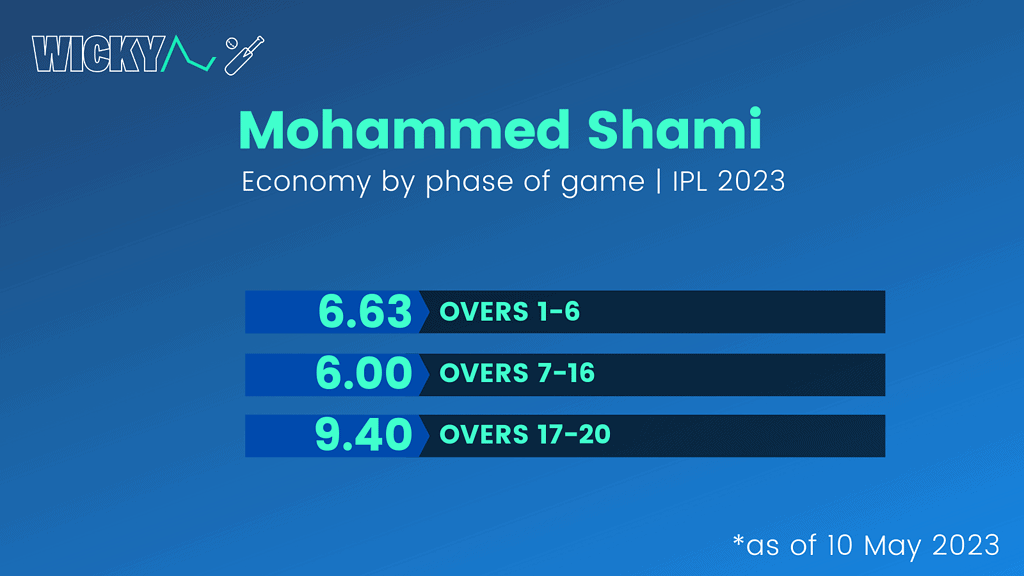
An economy rate in the mid-9s at the death is quite respectable, a mark in the mid-6s in the powerplay is pretty good – and a run-a-ball mark in the middle phase looks best of all.
The redistribution of Shami’s overs has reshaped him into Bhuvneshwar Kumar.
But those numbers don’t tell the full story, because Shami’s role for Gujarat has changed substantially from last season.
Still predominantly a powerplay bowler, Shami nevertheless bowled a decent chunk of his overs in the middle phase last season – in fact, almost as many as he bowled in the final four overs.
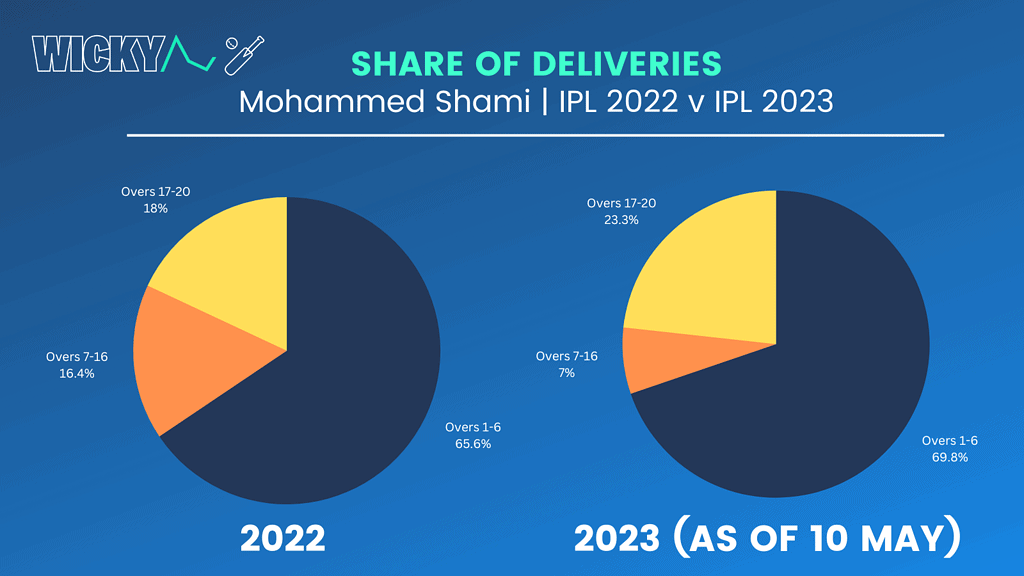
Simply put, in 2022 Shami was two-thirds a powerplay bowler and (almost exactly) equal parts a middle overs & death overs bowler.
Ever wanted to compare your favourite IPL batters or see who’s got the most sixes with a minimum of 200 runs? You can do all this and more with our new interactive IPL dashboard!
Shami and his new role
But there’s been a significant shift in 2023. Mohammed Shami is now bowling a larger proportion of his deliveries in the powerplay and death – and a much smaller proportion in the middle ten.
In fact, over 13 against Lucknow Super Giants at Ahmedabad was only the third over he’s bowled in the middle phase all season. That economy of 6 in overs 7-16 this season comes from a really small sample size.
The redistribution of Shami’s overs – increasingly, two up top, two at the end – has reshaped him into Bhuvneshwar Kumar.
It’s not hard to see why the redistribution occurred either. Last season, Shami travelled in overs 7-16. From 10 overs in the middle phase, he went at more than 11 an over.
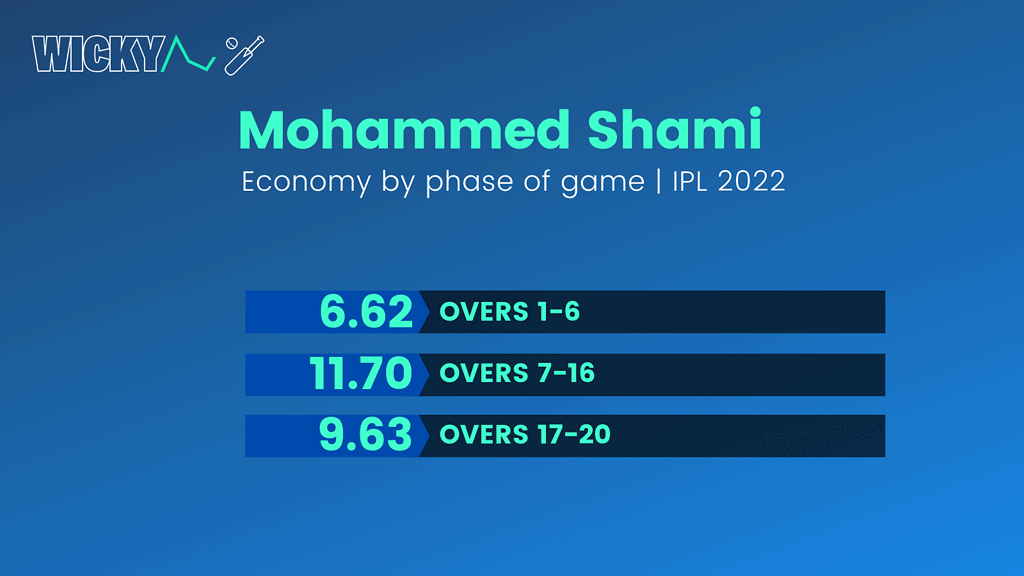
Remarkably, his powerplay and death overs economy rates are almost identical in 2022 and (so far) in 2023. These figures suggest consistency, but when you consider that he’s bowling way more in those phases this season than last, they suggest improvement all the more.
Shikhar Dhawan has become a monster boundary hitter – at the expense of pretty much everything else.
Shami’s returning the same numbers while bowling proportionally more in the opening and closing stages. Shielded from his unfavoured phase, he’s flourishing in the new role, offering more control and building pressure more effectively.
Last season, his dot ball percentages in overs 1-6 and overs 17-20 were, respectively, 57.5% and 31.81%. This season, the equivalent figures are 60.55% and 33.33%.
The economy rates are practically the same, but Mohammed Shami has become a more effective bowler in many ways with the change in responsibilities.
Stats correct as of 10 May 2023
Check out our IPL T20 Cricket Match Simulator to see how your favourite stars perform over 100 simulations!
How Shikhar Dhawan has upped the pace in IPL 2023
Shikhar Dhawan is scoring way quicker in IPL 2023 than he did last year – but how?
Well, the short version is that he’s become a monster boundary hitter – at the expense of pretty much everything else.
Here’s the long version.
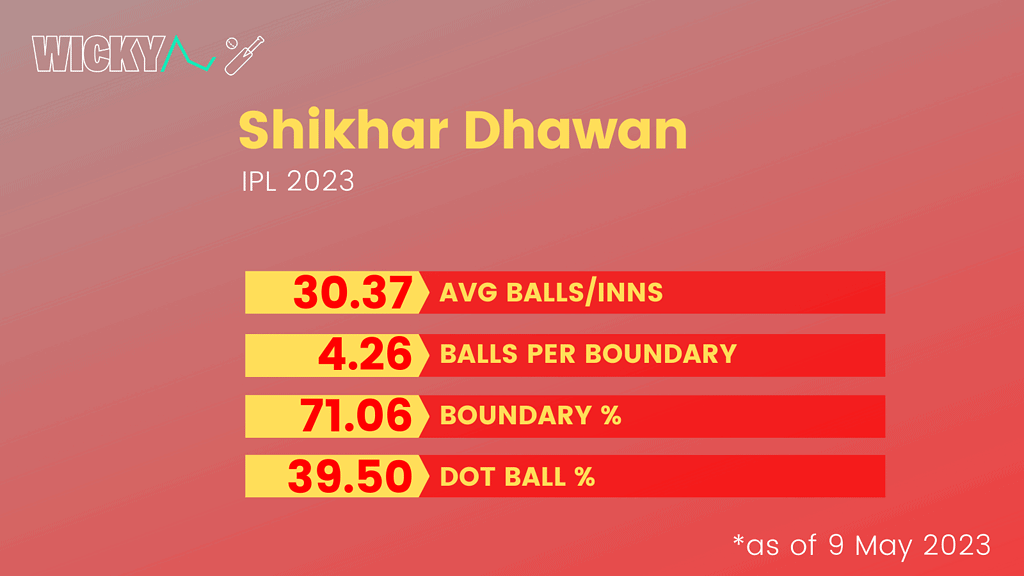
After eight innings in 2023, Dhawan is striking at 143 compared to 122 in 2022.
He’s the type to bat long, but the numbers are still ridiculous. Remarkably, Dhawan is facing an average of 30 balls an innings so far this season.
Dhawan is proving more than able to ‘catch up’ by hitting boundaries.
It’s not a shorter stay at the crease that’s inflating his strike rate. In some ways, it’s the opposite; in 2022, that mark was an average of 26.78 balls an innings.
Dhawan’s batting longer AND scoring faster this season than last and those boundary hitting numbers shed some light on why that is.
Last season, Dhawan found the fence worse than once every over – so far this year, that rate has sharpened by over 2 balls fewer between boundaries.
In 2022, 56% of his runs came from fours and sixes – that figure has jumped to a gargantuan 71% in 2023.
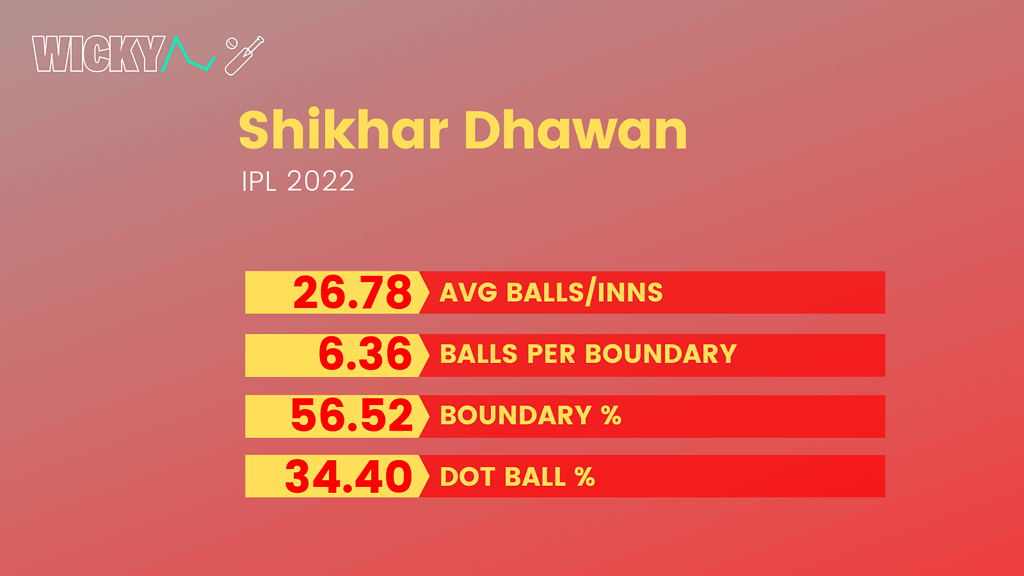
There’s always a tradeoff when it comes to scoring options & the most important number there is Dhawan’s dot ball %.
It’s actually risen significantly this season compared to last even as Dhawan’s overall scoring rate has gone up – and that’s the heart of the matter.
Wondering how our T20 Match Simulator works? Check out this article to know more
Dhawan finds the fence
He’s proportionally scoring off fewer balls than he did last season. But Dhawan is proving more than able to ‘catch up’ by hitting boundaries.
In eight innings in IPL 2023, he’s already hit almost as many boundaries (47 fours/10 sixes) as in 14 innings in 2022 (47/12).
Interestingly, Dhawan’s strike rate has picked up in the middle overs compared to the first six both this season and last.
The key this year is that his strike rates in both phases are up significantly.
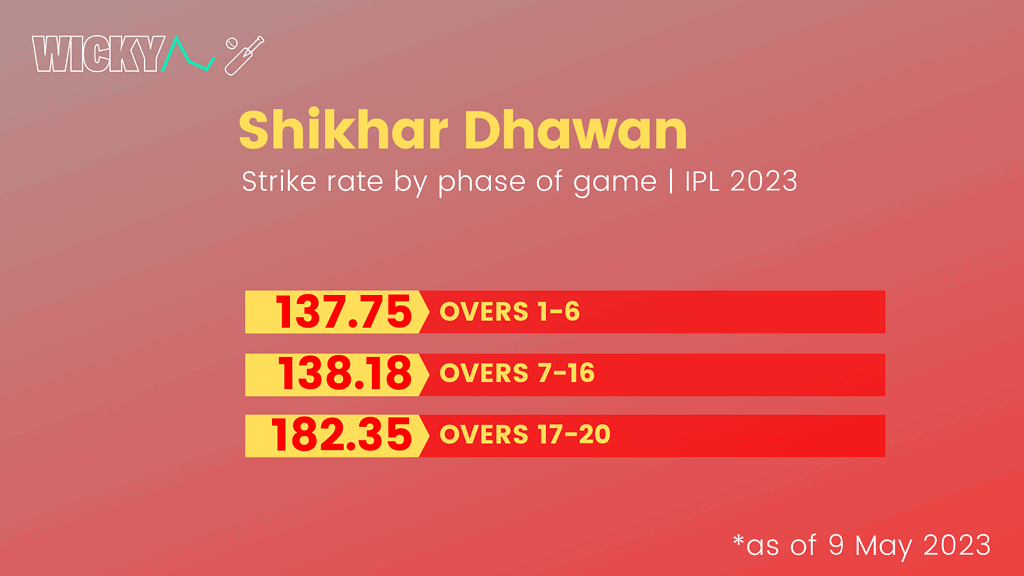
Dhawan’s increase in strike rate from the first six to the next ten is very slight, although the same increase in 2022 wasn’t huge either.
Kuldeep Yadav has been on a ridiculously dominant run against his old team.
His scoring rate across phases is definitely more consistent this year. However, the increase of those rates from 2022 is what’s significant.
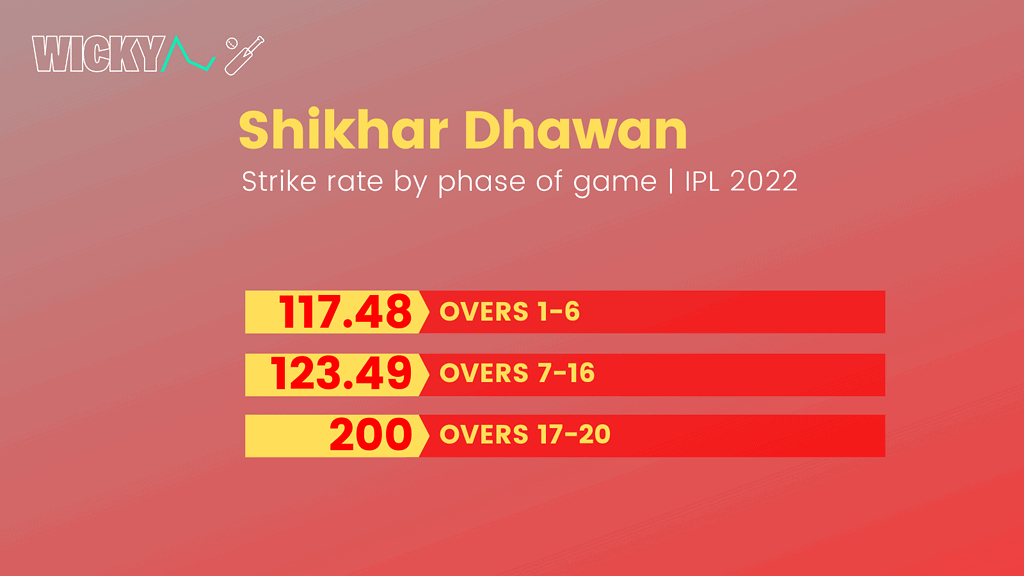
Despite the late blitz during the 99* v Sunrisers Hyderabad, Dhawan’s strike rate in the death overs is notably lower this season than last.
Treat that with caution though. He’s faced 34 balls in overs 17-20 in IPL 2023 compared to 17 balls in 2022.
Stats correct as of 10 May 2023
Want more IPL analysis? Check out the case for why Axar Patel should stay in his current batting position at Delhi Capitals & much more
Kuldeep Yadav dominates KKR
In the ‘ex-player does brilliantly against former team’ stakes, it’s fast becoming difficult to look past Kuldeep Yadav v Kolkata Knight Riders in the IPL.
Since switching to the side from the capital ahead of the 2022 season, Kuldeep has been on a ridiculously dominant run against his old team.
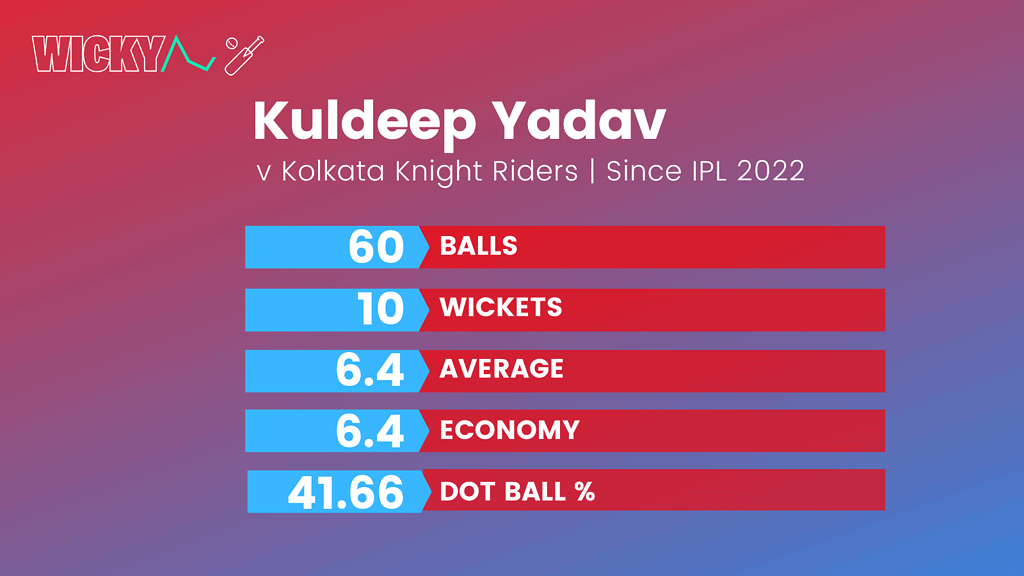
Across three games since the start of last season, he’s bowled 60 balls & grabbed 10 wickets – that’s a pole every over.
It’s not every day you see the same mark for an average & an economy rate but Kuldeep’s paying just 6.4 runs per wicket AND per over playing for Delhi against Kolkata.
Plus, over 40% of his deliveries have given no runs in these games. He actually improved his mark from last season in the encounter with KKR at Delhi this year.
After the two games in 2022, his dot ball % against Kolkata stood at 35.71% & an economy of 7 – good, but not his best.
Kuldeep had a better dot ball % against three sides – Punjab (42.86%), Gujarat, and Hyderabad (both 41.66%). His economy, meanwhile, was better against both Punjab (5.43) and Mumbai (6.38).
Building pressure
But as far as wickets go, KKR are easily Kuldeep’s favourite opponent since switching to Delhi.
Last season, he took twice as many wickets against them as against the next best – 4 each v Mumbai & Punjab.
And after another two-fer against KKR in 2023, Kuldeep’s overall dot ball % against this opponent too sharpened to 41.66%.
Dhoni’s current role is able to extract the most out of him.
Overall, his pressure building through dot balls has been pretty consistent as well. In these three games, he’s bowled 8, 8 & 9 dot balls in spells of 4, 3 & 3 overs – there’s an elegance, a harmony to his domination.
So how’s he done it? For one, Kuldeep’s ruthlessly cleaned up the tail – his 10 wickets include Umesh Yadav, Pat Cummins & Anukul Roy.
But the most interesting bit concerns matchups – Kuldeep has twice dismissed both Shreyas Iyer & Sunil Narine in these games.
We’ve got some more cool numbers on Sanju Samson, Rohit Sharma, Bhuvneshwar Kumar & Sunil Narine!
MS Dhoni is thriving in his role at CSK
Among frontline sticks at the Chennai Super Kings, MS Dhoni is doing splendidly on a number of metrics. When looking at strike rate v dot ball % Dhoni, along with Ravindra Jadeja and Ajinkya Rahane are way ahead of the rest for the latter.
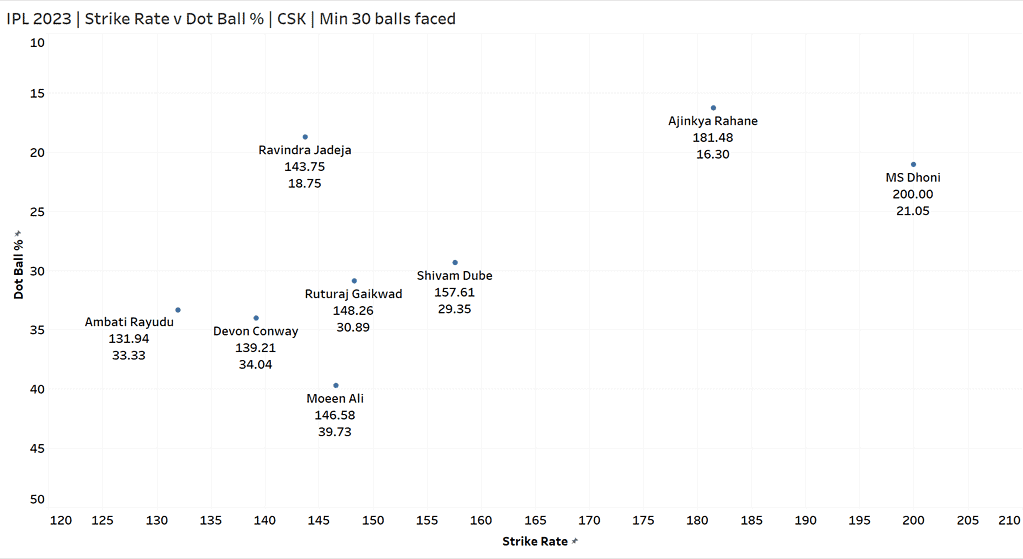
Also worth noting is the position of all-rounder Moeen Ali. He’s above both Jadeja and top scorer Devon Conway for strike rate but easily the worst of this group for dot ball %.
Meanwhile, Shivam Dube probably deserves a bit more credit for his season – third for strike rate & fourth for dot ball % at Chennai.
When comparing sixes to fours, Conway ranks well above the rest for fours. Meanwhile, Ruturaj Gaikwad is somewhat underrated as a six-hitter. He’s second at CSK and joint-fifth in the IPL.
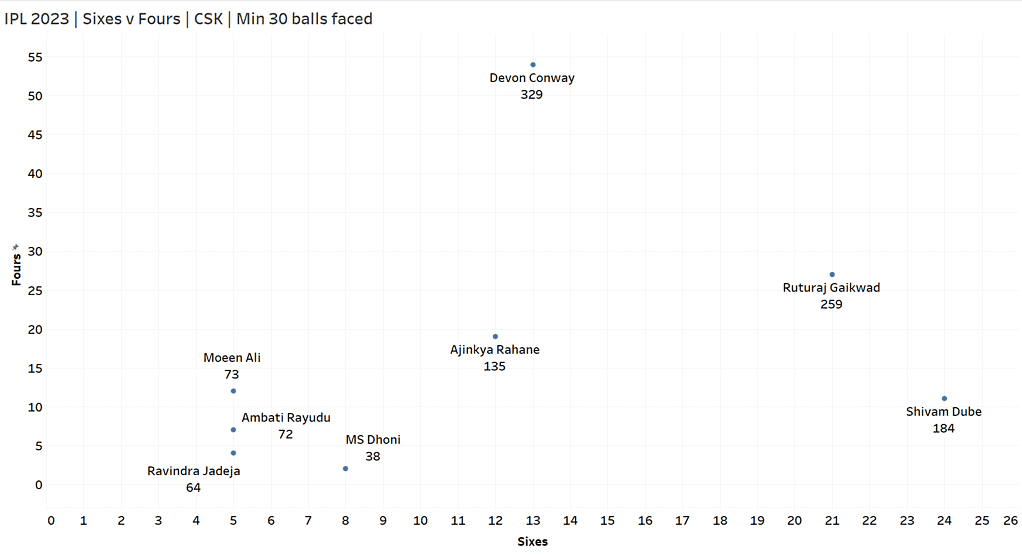
Dhoni’s role – arriving at the very end – requires him to swing for the fences from the off. That approach reflects in this chart. Despite playing just over half the deliveries, the captain is ahead of Ambati Rayudu, Moeen, and Jadeja for sixes.
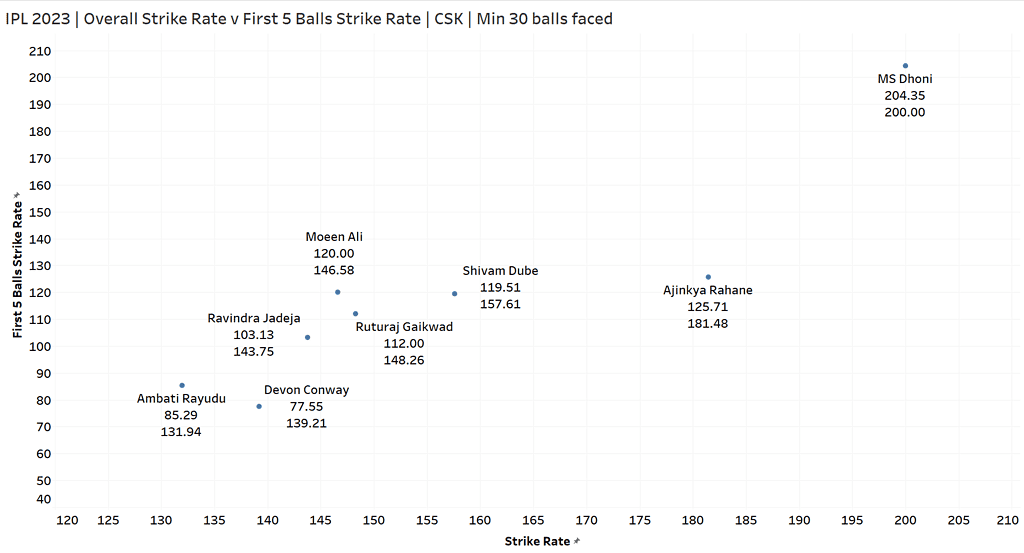
When comparing starts with overall strike rates, it’s top right Dhoni once again. His use by CSK has been perfect: Dhoni’s current role is able to extract the most out of him.
But apart from Dhoni, everyone else in this group starts quite slowly. Top scorer Conway the slowest of all, striking at 77 in his first five balls.
Visit our friends at flashscore.com.au for live cricket scores from all major T20 leagues including the Indian Premier League, Big Bash League, T20 Blast, Pakistan Super League, NZ Super Smash, SA20, and more!
Chennai excel at hitting boundaries
Lastly, an analysis of the best boundary hitters at Chennai reveals top right Dhoni once again.
But this time his peers are putting up seriously impressive numbers too.
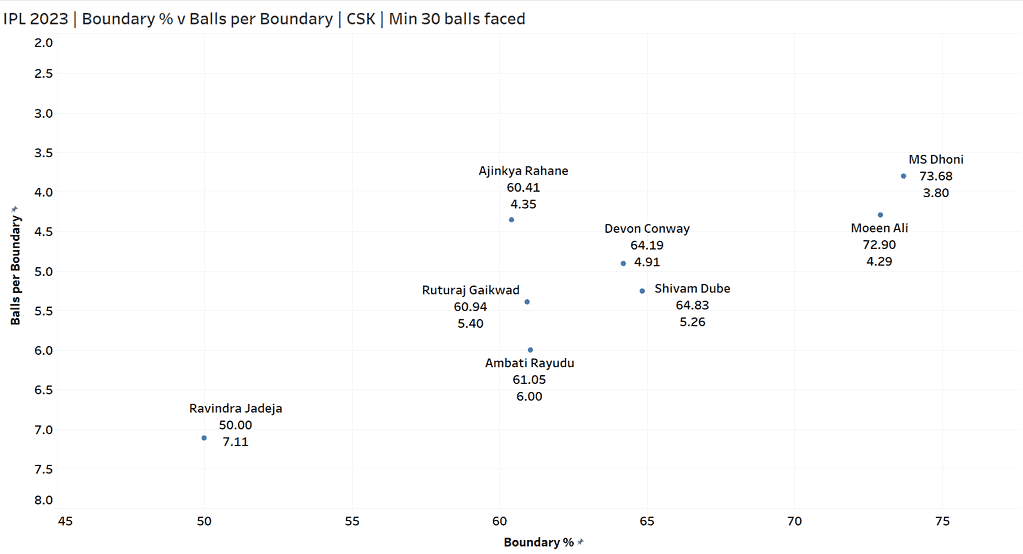
7/8 in this group get over 60% of their runs in fours and sixes this season. This time, it’s Moeen who is arguably underrated for the regularity of his boundaries. He’s second only behind Dhoni in balls per boundary.
By contrast, while fours and sixes are an important scoring option for Shivam Dube, their frequency is positively middling. He’s fifth in a group of eight.
Stats correct as of 10 May 2023
Header image: Aidan Sammons/CC BY 2.0/https://creativecommons.org/licenses/by-sa/4.0/legalcode
If you want to follow more of our IPL analysis or any of our other work at Wicky, please reach out via email or on social media.